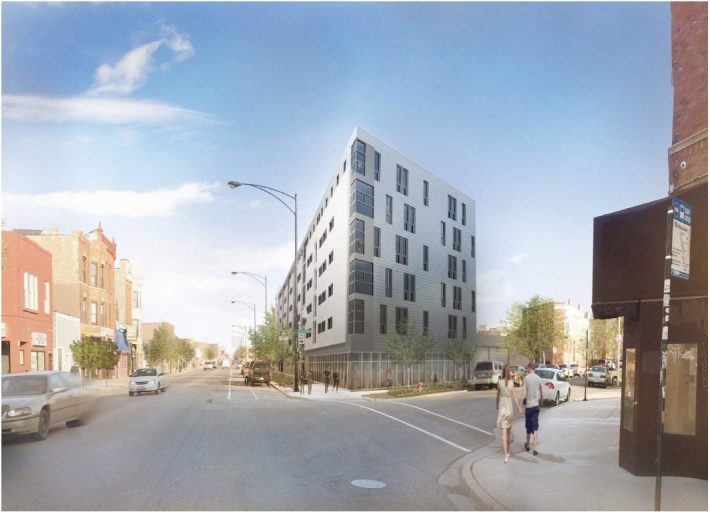
A site that's currently a staging area for Your New Blue 'L' station renovation may soon be home to a transit-oriented mixed-use building. Property Markets Group has proposed a new apartment building for Logan Square that will provide half the normally required car parking, bringing needed housing with less congestion.
Parking minimums for this and most residential proposals in Chicago require one parking space per unit, plaguing neighborhoods with more traffic and developers with unsold space. However, a TOD ordinance enacted a year ago allows residential developers like Noah Gottlieb of PMG to build up to 50 percent fewer car parking spaces if the building is located near a train station.
Without a Pedestrian Street designation, developers would have to find an empty parcel within 600 feet of a train station. The PMG residence's main entrance, though, is just over 700 feet away from the California Blue Line station, and Alderman Proco "Joe" Moreno implemented a Pedestrian Street here last year. It covers multiple empty parcels and increases the distance to 1,200 feet a development can be from a train station and still be eligible for the benefits.
PMG has proposed a six-story mid-rise building at 2211 N Milwaukee Avenue, adjacent to the Chase Bank-anchored strip mall and across from the Madison Public House restaurant, which opened in the spring. The building would have 120 units with 60 car parking spaces (and seven more for the ground-floor retail). Seventy percent of the units would be studios, junior one-bedrooms, and one-bedroom apartments.
Since the TOD ordinance requires that a bike parking space replace every normally required car parking space, PMG will be doing that, and then some. Gottlieb said they're proposing 216 bike parking spaces because PMG does all of its parking calculations "on the projected amount of people, not units."
Gottlieb also wants to do away with parking minimums, adding that the developer should decide how much parking to build. He explained that the motivation to build less parking at this development is because it's "in line with the marketplace." He continued:
There're a lot of antiquated zoning rules in regard to parking. Especially in Logan Square, very few people drive to work in the young renter demographic, they're using public transportation, and biking and walking. We anticipate very little demand for our parking spots.
Parking minimums are one of those antiquated rules. They were originally intended to ensure that everyone who wants to drive finds a place to park at their destination, regardless of that place's transit accessibility, but instead they ended up encouraging more people to drive. Developers don't need a zoning mandate to ensure their tenants or customers have a way to access their homes and shops: They'll do that all on their own. Parking minimums also drive up the costs of construction, which are passed on to tenants when parking is bundled with rent.
We can head off complaints of "density means traffic" and "more units brings more traffic congestion" right now. The population of Logan Square in the area bounded by Western, Fullerton, California, and Armitage, has declined by 17.3 percent from 2000 to 2010 even while the number of housing units increased by 3.2 percent. The number of cars (and amount of traffic) is dictated by the number of places to park, and Logan Square is a place that's proud to be walkable and bikeable.
Gottlieb said this will be his first development under the TOD ordinance and suggested that the ordinance be expanded to more zoning districts, and that the city consider bus service and walking distance to downtown in determining what makes a transit-accessible location.
"Just as many people take the bus as the train," Gottlieb said, "but buses don't count for the ordinance." Actually, 57 percent of weekday trips are by bus, although bus ridership has been on a sharp decline since 2010, likely because of rising multi-day pass prices.
Another factor Gottlieb thinks the zoning ordinance should consider is walking distance to downtown. He reasoned that putting a building a 10 minute walk from downtown should be looked at similarly to the one that's built further away but is still 10 minutes away from downtown by train.
Benett Haller, director of urban design and planning at the Department of Planning and Development, said he's excited that the private market is trying to create a better environment around train stations by building less parking. "It's a market-driven fact," he said, "that developers cannot sell or market all of the parking spaces in a residential development." Haller also said his department is getting pressure from developers in certain parts of the city to reduce their parking requirements when they're far from a train station. PMG is now one more company in a growing group of developers availing themselves of the city's nascent TOD ordinance, to result in less parking and congestion.





